
There is so much ground to cover on this particular rifle, I decided to publish it in two parts. The first part addresses the product’s design, details of the rifle’s operation and some facts that may be useful to a potential consumer. The second part will address the rifle’s function and performance and hopefully some insight into the R8’s value. I started off thinking Lexus, discovered a lot of Ferrari, or more appropriately Porsche, so now I am working through this for my benefit as much as for our readers. For many people, it might be a little tough to think of buying an R8 in this economy, but maybe soon and in the mean time it makes for a great future goal. The example covers .308 Winchester and .375 H&H configurations.
A modular approach…
The idea of producing a modular rifle is not new, nor is it unique. The simplest modular approach may be the single shot products of Thompson Center where stocks and barrel swaps control chamber and long gun/handgun configurations. The Krieghoff Semprio is an inline bolt action repeater that, through interchangeable barrels, can be configured to a long list of standard and magnum cartridges. Even Savage brought interchangeable barrels and bolt heads to budget bolt action rifles. What is different from one company’s product to another is the approach taken to constructing a modular system, how the concept is executed and the quality and performance of the finished product. In this regard, the R8 is a standout.
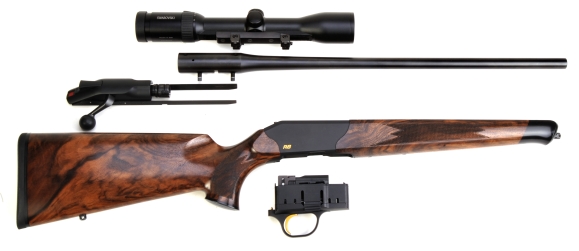
Configuring for different cartridges

Blaser barrels are available for approximately thirty-two different cartridges. Dependent upon cartridge selection, barrels come in four lengths and in three different contours. There are five types of bolt heads, two that are primary. By size, there are three forearm selections to match barrel contours.
Converting from one cartridge to another requires a change of two parts as a minimum to four parts as a maximum. Cartridges within the same general family require only a barrel and magazine insert change. Cartridges with differing case heads also require a bolt head change. Differing barrel contours require a forearm change to one with a matching barrel channel. A minimum change over can be accomplished in less than a minute. The addition of a bolt head adds about a minute more as does a forearm change. If your a person who likes to work at a more leisurely pace – ten minutes, worse case. The R8 really is designed to routinely support these types of changes in configuration.
The barrel assembly…
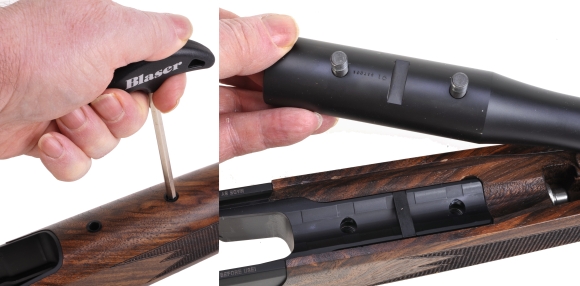
A couple of driven barrel nuts in the forearm secure the barrel. Blaser supplies a hex driver specifically for this purpose. The two threaded studs pass through the bedding block that is an integral part of the rifle’s action and the groove in the barrel locks into the recoil lug that is situated midway between the two stud holes. It is a very solid support for the barrel, which free floats the rest of the way through the forearm.
Some magazine details…
Magazine inserts are made of fiber filled plastic and fit inside what Blaser terms a “spare magazine”. No tools are required to remove the insert from the magazine or the spare magazine from the R8. A magazine insert is supplied with each barrel, however, some magazine inserts overlap calibers. As examples, the insert for the .308 Winchester cartridges also works with the .243 Winchester. The .375 H&H insert also works with the 6.5x68mm and the 8x68mm S.
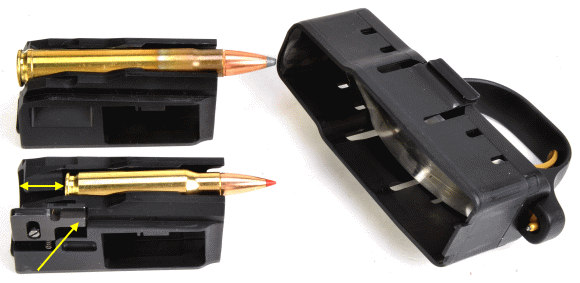
Magazine inserts serve a couple of important functions. The first is to reliably feed cartridges based upon their size and geometry, the other is to establish proportional bolt travel for the R8. As noted by the arrows in the picture above, short rounds like the .308 Winchester are located much farther forward in the magazine insert and a spring loaded bolt stop limits the bolt’s travel when the gun is configured for shorter rounds. A considerate feature when a rifle has so much potential bolt stroke capacity. Each magazine also has a safety position that locks it into the receiver so it can’t be released by simply squeezing on the side release tabs. In this configuration, the gun’s bolt is opened and the rifle is loaded from top side rather than directly into the magazine.
Magazine inserts hold three rounds of .375 H&H (magnum ammo), four rounds of .308 Winchester (standard ammo) and five rounds of .223 Remington (mini ammo). This pretty much follows through to cartridges of similar proportion. The 500 Jeffery insert holds two rounds which, in my personal experience, is one round more than necessary to render the shooter unconscious.
Bolt head detail…

The R8 has different bolt heads to adapt the rifle to different cartridge case heads, however, each bolt head covers a wide range of cartridges. The top bolt head pictured covers all .308 Winchester and .30-06 Springfield family cartridges, plus the popular 7mm and 8mm non magnum cartridges and the .22-250 Remington. The lower bolt head covers all of the belted and non belted magnums from the .257 Weatherby to the .500 Jeffery, including the .375 H&H pictured. There are a total of five cartridge categories that determine bolt head selection, however, two are for very narrow applications.
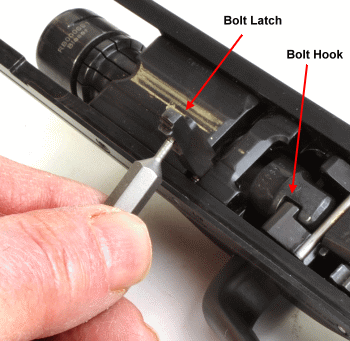

| Quick Specs | CZ 550 | R8 |
| Weight | 9 lbs 2 oz | 7 lbs 2 oz |
| Overall Length | 46″ | 43″ |
| Barrel Length | 25″ | 25¾” |
The .375 H&H is one of my favorite cartridges. The round is a heavy hitter, but it shoots like a .30-06 Springfield in terms of accuracy and trajectory and recoil is… moderate. One of my personal guns is a frequently used CZ 550 Magnum which has all of the characteristics of an express rifle which, unfortunately, means long and heavy. The Blaser is 3″ shorter in overall length with the same length barrel.
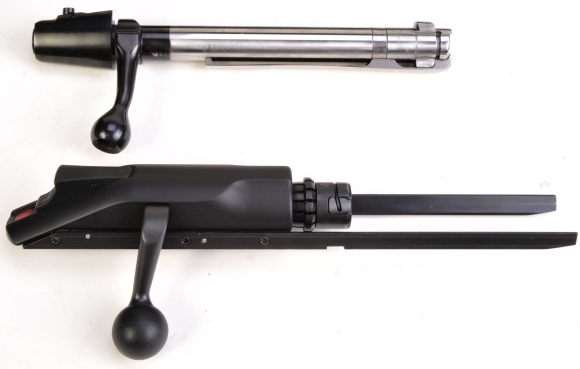
A conventional turn bolt rifle is of inline construction with the fixed action and moving bolt all located aft of the barrel’s breech face. Consequently, the length of the action and bolt are additive to the length of the barrel.

The Blaser’s bolt assembly has outrigger rails that travel in grooves cut into the inside walls of the gun’s receiver and on into clearance cuts in the gun’s forearm. This allows the rails to travel outside of the barrel and beyond barrel’s breech face when the action is closed. The result is that the action can close down to a compact action length of only 5″ where the conventional CZ 550 magnum action is 8″ long when closed, approximately the 3″ difference in overall rifle length that was noted earlier.
The outside rail design allows for a compact closed assembly, but it also makes for very slick, linear resistance travel. Absent is the locking lug drag, extractor bind, radial cam resistance associated with most Mauser type bolt actions. The R8 bolt can open a full 4¾”, however, cartridge length capacity is limited to magazine length and the magazine length on this specific example .375 H&H measured 3.660″. This is more than adequate for all of the really big cartridges; 375 H&H, 458 Lott, .500 Jeffery…
Collet what you like, it works really well…
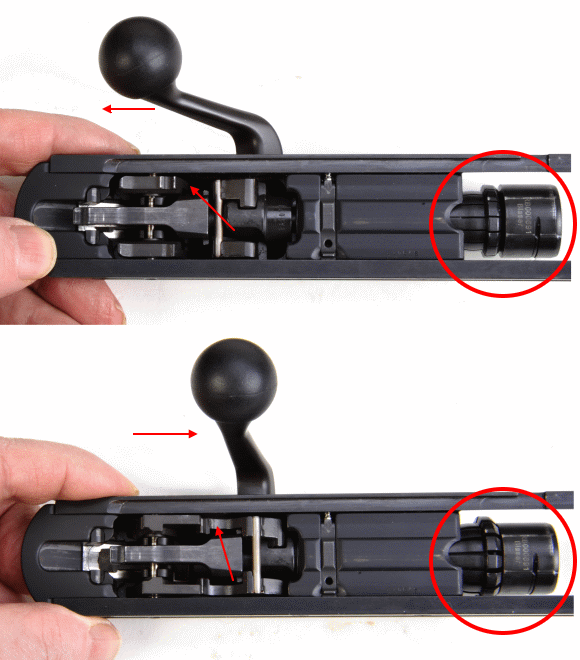
The Blaser’s bolt does not rotate in an axial fashion; in fact it remains in a fixed position. The bolt handle rotates fore and aft approximately 45°; aft to unlock the bolt. Once unlocked, the bolt handle carries the entire bolt assembly aft to extract and eject and forward to chamber a round. With the bolt handle rotated aft, top picture, the radial locking lugs (circled) are collapsed to a measured 0.807″ in diameter. With the handle rotated forward, locked, the bolt’s radial lug arrangement expands to a measured 0.962″ and locked into a radial recess in the barrel’s shank. In short, the bolt is not going anywhere once locked. Neither operating pressures nor bolt thrust is going to make it budge and the concentric circle of radial lugs and radial groove in the barrel shroud pull the bolt head into perfect alignment with case head and bore axis.

The R8 is push fed with a short spring loaded extractor and plunger type ejector. The magazine insert’s grip on a cartridge seems better than when a simple follower type mechanism is employed and the insert retains the cartridge longer. A cartridge rim and case head are fully encircled in the R8’s bolt head.
Each barrel’s breech face is recessed just under one inch into the barrel. While this means the R8’s net barrel length is approximately one inch shorter than a comparable barrel length rifle with a conventional threaded shank barrel, this arrangement means cartridge case and bolt are surrounded by barrel steel. Gas venting in the event of a case failure is just aft of the breech face and directed out and away from the shooter.
Trigger without Roy Rogers…
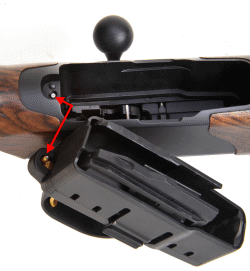
Blaser terms the trigger in the R8 “desmodromic”. The Greek roots of the word means “controlled track” and it is most often applied to a valve that is closed by cam and linkage rather than by spring pressure. This is the case with the Blaser design where the trigger is reset with cam and linkage rather than by a return spring.
The visible trigger, which is affixed to the removable magazine assembly, is a simple pivoting lever. The load side of the lever contacts a pushrod that passes up through the receiver which, in turn, depresses the sear that is located directly above as a component of the bolt assembly. Other than the actual trigger and pushrod, all of the other trigger components are located within the bolt assembly. I apologize for using generic parts terminology, but there was no exploded diagram available with Blaser piece part nomenclature.
The trigger is excellent. Short release, crisp and no creep. I thought the trigger pull consistency was pretty amazing. Within twenty cycles trigger pull ranged from 1 lb 14.5 oz to 1 lb 14.8 oz. The trigger pull is owner adjustable with adjustment accomplished by simply applying more or less finger pressure on the trigger.
Striving for a safer Europe…

The big button on the heel of the gun’s receiver is the safety or cocking slide. Unlike a conventional turn bolt rifle that is cocked by rotating the bolt open or closed, the Blaser R8 must initially be manually cocked by pushing the safety slide forward until it locks and exposes the red international symbol for “I have a really strong thumb”. From that point on, the gun is cocked whenever the bolt is cycled and remains in that state until the gun is decocked or the magazine is removed. The gun is decocked, by pushing forward and down on the button, then releasing pressure. Decocking also locks the gun’s bolt in the closed position.
While I am a fan of a decocking feature on autoloading pistols, it is a bit counterintuitive in hunting situations where the preference is to be on functional autopilot. Additionally, the large button, in relationship to the other lines of the receiver make it appear as an afterthought. A similar set up is also employed on the company’s very popular $10,000 S2 double rifles, which suggests pretty much everyone, except for me, embraces the concept. In some parts of the world decocking and manual cocking has become a requirement, which may be why other brand firearms from Europe from Mauser to Krieghoff have systems of similar function.
Scope mounting…
The R8 utilizes Blaser’s proprietary Saddle Mount approach to scope mounting. The system is simple and quite practical, particularly for a switch barrel firearm. The Saddle Mount is available in ring mount and rail mount configurations. Individual ring sets for the more conventional mount are available in popular sizes and installed heights. The rail mount option is designed to work with Swarovski and Zeiss scopes intended for this type of application.

The R8’s rail mount may be positioned anywhere along the bottom of a scopes rail to adjust for optimal eye to eye piece positioning. Interlocking teeth between rail mount and scope rail and three Torx type fasteners secure the adjustment.
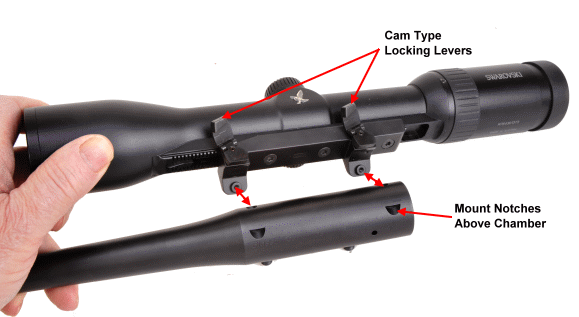 .
.
Once mount and scope are married, the same applies to ring type mounts; the assembly is located at indentations in the gun’s barrel located just above the barrel’s chamber, and the cam lock levers are rotated into the locked on position. The lockup is very solid and zero was not lost by removing and reinstalling the scope. Nice design, few moving parts and very clean looking on a nice rifle. I do not know if rail mounts are a developing trend or if the installed base of less costly scopes is too massive to allow design migration in this direction. Quite frankly, I’m amazed more scope manufacturers haven’t been more aggressive in design to make sure their products are mounted perpendicular to a rifle’s bore.

At times when only complete decadence will do, mounting a Zeiss iC series scope will assure the scope’s illuminated reticle will switch on when the R8 is cocked. No further comment, but I believe this is the type of vanity feature that caused Satan to become a fallen angel in Milton’s Paradise Lost. No, I don’t know why I used that particular reference, other than over exposure to an expensive European rifle. Anyway, the Blaser Saddle Mount system, ring or rail, is no gimmick. It is probably the best engineered quick release system I have experienced.
Epilogue… Always want to write that

Ultimately, aesthetic appeal and interesting engineering take a back seat to how accurately a rifle places shots and how predictably it functions. Part II will take us to the range with a pile of factory and handloaded ammunition and a summary of the R8’s performance. I promise it won’t be as boring as this last paragraph.

Email Notification